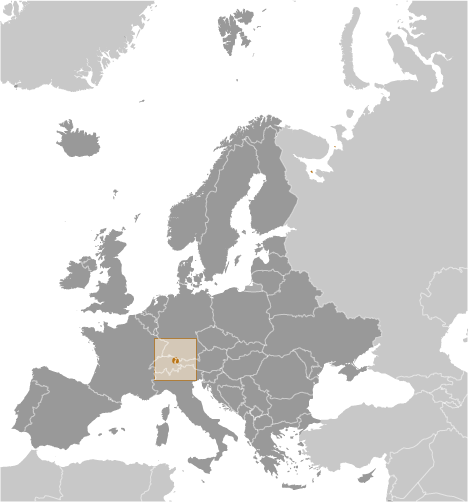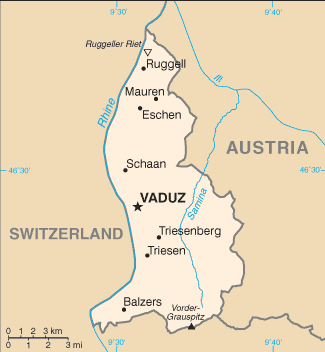
|
|
Advertisements:
EconomyEconomy - overview
Despite its small size and limited natural resources, Liechtenstein has developed into a prosperous, highly industrialized, free-enterprise economy with a vital financial service sector and likely the second highest per capita income in the world. The Liechtenstein economy is widely diversified with a large number of small businesses. Low business taxes - the maximum tax rate is 20% - and easy incorporation rules have induced many holding companies to establish nominal offices in Liechtenstein providing 30% of state revenues. The country participates in a customs union with Switzerland and uses the Swiss franc as its national currency. It imports more than 90% of its energy requirements. Liechtenstein has been a member of the European Economic Area (an organization serving as a bridge between the European Free Trade Association (EFTA) and the EU) since May 1995. The government is working to harmonize its economic policies with those of an integrated Europe. Since 2008, Liechtenstein has faced renewed international pressure - particularly from Germany - to improve transparency in its banking and tax systems. In December 2008, Liechtenstein signed a Tax Information Exchange Agreement with the US. Upon Liechtenstein's conclusion of 12 bilateral information-sharing agreements, the OECD in October 2009 removed the principality from its "grey list" of countries that had yet to implement the organization''s Model Tax Convention. By the end of 2010, Liechtenstein had signed 25 Tax Information Exchange Agreements or Double Tax Agreements. In 2011 Liechtenstein joined the Schengen area, which allows passport-free travel across 26 European countries. Gdp (purchasing power parity) World Ranking: 167
$5.003 billion (2009)
$5.028 billion (2008) $4.16 billion (2007) Gdp (official exchange rate)
$4.503 billion (2009)
Gdp - real growth rate World Ranking: 201
-0.5% (2009 est.)
1.8% (2008 est.) 3.1% (2007 est.) Gdp - per capita (ppp) World Ranking: 1
$141,100 (2008 est.)
$147,500 (2007 est.) Gdp - composition by sector
Agriculture 8%
Industry 37% Services 55% (2009) Labor force World Ranking: 202
34,330 (2009)
Note 51% of people at work in Liechtenstein commute daily from Austria, Switzerland, and Germany (2009) (2010) Labor force - by occupation
Agriculture 0.8%
Industry 41.3% Services 56% (2009) Unemployment rate World Ranking: 23
2.8% (2009)
1.5% (2007) Population below poverty line
NA%
Household income or consumption by percentage share
Lowest 10% NA%
Highest 10% NA% Budget
Revenues $943 million
Expenditures $820 million (2008 est.) Taxes and other revenues World Ranking: 154
20.9% of GDP (2008 est.)
Budget surplus (+) or deficit (-) World Ranking: 23
2.7% of GDP (2008 est.)
Inflation rate (consumer prices) World Ranking: 6
0.3% (2011)
0.7% (2010) Market value of publicly traded shares
$NA
Agriculture - products
Wheat, barley, corn, potatoes; livestock, dairy products Industries
Electronics, metal manufacturing, dental products, ceramics, pharmaceuticals, food products, precision instruments, tourism, optical instruments Industrial production growth rate
NA%
Exports World Ranking: 126
$2.79 billion (2009)
$3.92 billion (2008) Exports - commodities
Small specialty machinery, connectors for audio and video, parts for motor vehicles, dental products, hardware, prepared foodstuffs, electronic equipment, optical products Imports World Ranking: 163
$1.73 billion (2009)
$2.59 billion (2008) Imports - commodities
Agricultural products, raw materials, energy products, machinery, metal goods, textiles, foodstuffs, motor vehicles Debt - external World Ranking: 204
$0 (2001)
Exchange rates
Swiss francs (CHF) per US dollar - 0.888 (2011)1.0429 (2010) 1.0881 (2009) 1.0774 (2008) 1.1973 (2007) Fiscal year
Calendar year
Comments
Add a new comment: |
Advertisement
Members area
Liechtenstein (Vaduz):
 
GPS points from Liechtenstein (Vaduz)
|
||||||||

 The Principality of Liechtenstein was established within the Holy Roman Empire in 1719. Occupied by both French and Russian troops during the Napoleonic wars, it became a sovereign state in 1806 and joined the Germanic Confederation in 1815. Liechtenstein became fully independent in 1866 when the Confederation dissolved. Until the end of World War I, it was closely tied to Austria, but the economic devastation caused by that conflict forced Liechtenstein to enter into a customs and monetary union with Switzerland. Since World War II (in which Liechtenstein remained neutral), the country's low taxes have spurred outstanding economic growth. In 2000, shortcomings in banking regulatory oversight resulted in concerns about the use of financial institutions for money laundering. However, Liechtenstein implemented anti-money-laundering legislation and a Mutual Legal Assistance Treaty with the US that went into effect in 2003.
The Principality of Liechtenstein was established within the Holy Roman Empire in 1719. Occupied by both French and Russian troops during the Napoleonic wars, it became a sovereign state in 1806 and joined the Germanic Confederation in 1815. Liechtenstein became fully independent in 1866 when the Confederation dissolved. Until the end of World War I, it was closely tied to Austria, but the economic devastation caused by that conflict forced Liechtenstein to enter into a customs and monetary union with Switzerland. Since World War II (in which Liechtenstein remained neutral), the country's low taxes have spurred outstanding economic growth. In 2000, shortcomings in banking regulatory oversight resulted in concerns about the use of financial institutions for money laundering. However, Liechtenstein implemented anti-money-laundering legislation and a Mutual Legal Assistance Treaty with the US that went into effect in 2003.